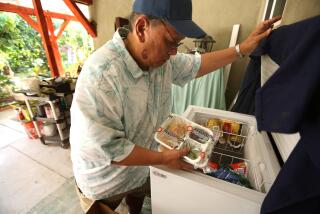The Other Harvest : Senior citizen volunteers find food for the needy after farmers leave their fields.
- Share via
The weathered hands tremble as they touch the leaves.
The sun is burning morning dew off the fields, but raising beads of sweat on Lester Begley’s furrowed forehead. He’s had to take it easy since his stroke a few years ago, but he thinks he’ll pick a few more buckets anyway.
A few rows over, Norm Rohn, wearing a battered Panama hat and a wild gray beard, vigorously lops a cauliflower off its stalk, and looks over the green rows for further booty.
He finds it--plenty of it--as do the hundreds of other gray-haired laborers who come to Ventura County fields with a spirit of charity in the hours just after dawn. Because of them, the offerings on the Thanksgiving Day table will be more abundant for many who would have a difficult time providing basic foodstuffs.
Last year, the folks who call themselves “gleaners” retrieved about 2 million pounds of vegetables and fruits from fields about to be plowed under and orchards that pickers had already worked. The bounty was funneled to thousands of poor people through about 150 organizations, and traded to food banks outside the county for other kinds of produce.
The average age of the gleaners is about 70, but that--and a purpose in their picking--is all they share. Some are retired physicians, bound for the golf course after a few hours of harvest; others once were pipe-fitters, plumbers, firefighters, homemakers and ordinary people who enjoy the feel of damp soil underfoot and warm sun overhead.
Started in 1978
The gleaner program started in 1978 out of the two-car garage of Harry Fox, a retired oil-field mechanic, and his wife, Evelyn.
“When I used to check on oil wells and work on compressors over in the fields, I’d see farmers plowing half of the crops back into the ground,” Fox said. “It seemed a shame so much was being wasted.”
The Foxes joined about 15 other people in a campaign against hunger spearheaded by Oak View minister Virgil Nelson. Nelson also had been thinking about the bounty that is plowed back into the fields.
“We were just reviving something several thousand years old,” Nelson said. “There is a strong injunction in Leviticus for people to take care of the sojourners and the poor. One of the ways is to not strip the fields, to leave corners of the fields for the widows and the orphans and the poor and the sojourners.”
In Ventura County, people had been gleaning, at least for themselves, for some time. “There’d probably always been gleaning going on here,” Nelson said. “I remember it from when I grew up in the early ‘50s, but it was always somebody who knew somebody who knew a field had been picked and knew the farmer. We needed something more organized.”
The tough part was convincing the agricultural community it was a good idea.
“We had to assure the farmers we were not going to trample the food, destroy the fields, that we would have trained people and supervisors and that we were not selling what we picked,” Nelson said.
Harder yet was convincing the middlemen, the food brokers, that free food distribution would not infringe upon their profit margin.
“To the brokers who are managing and marketing these crops, food is not food,” Nelson said. “It is a commodity, something to make money with. I’ve stood in a broker’s office when he gave the order to plow under a field of lettuce. I stood there and I cried.”
But the group eventually gained the confidence of most of the farmers, he said, and convinced the brokers that their market would not be affected because the poor rarely bought produce, but survive on cheaper fare, such as beans and rice.
About a dozen people went out to reap those first tag-end harvests, and within six months, they had doubled their crew and given themselves the name FOOD Share. The acronym stands for Food On Our Doorsteps.
Grew More Sophisticated
For four years, “Evelyn ran it on one telephone and two clipboards out of our garage,” Fox said. The enterprising gleaners kept expanding the operation. They learned how to tie into other food banks, trading extra green beans from Oxnard for kiwis from Bakersfield. They arranged to pick up day-old bakery products and other expired stock from supermarkets. They added government commodities like surplus cheese to their stores and solicited donations from packing houses.
The day 2,000 boxes of bananas were delivered to the Fox’s home, “it began to get to us,” Fox said. They soon found a new base of operations in the old Saticoy firehouse, which the city of Ventura rented to them for $1 a year.
Evelyn Fox died two years ago, illness forced Harry Fox to retire from the fields, and Nelson has gone on to a new crusade to help the homeless, but FOOD Share kept growing.
The organization received a United Way grant and moved into a 12,000-square-foot warehouse in El Rio. It has five full-time, paid staff members, more than 500 volunteers and will supply 8 million pounds of food from all of its sources to charities this year.
FOOD Share is now tied into a national network called Second Harvest that allows the organization to send excess Ventura produce, such as lemons, avocados or tomatoes, to other food banks and receive artichokes from the Central Valley, enchilada sauce from Los Angeles or grapefruit from Phoenix.
Word of the gleaner program travels through a senior-citizen grapevine that wends through boccie-ball tournaments, square dances, garden clubs, knitting circles and happy hours at Leisure Village retirement community.
“I had been playing tennis and golf and all those recreational things for a few years,” said George Langston, 68, a retired high school coach and science teacher who moved to Camarillo from Chatsworth eight years ago. “I thought, ‘Well this is fine for me, but maybe I need to do something for somebody else as well.’ ”
Although anyone can be a gleaner, 90% of the volunteers are senior citizens, said Dan Wakely, the program’s director. The idea of gleaning seems to appeal to vigorous older people with an old-fashioned work ethic and a sense of thrift fostered by living through the Depression.
“I had some time on my hands and thought I could be a little useful,” said Norm Rohn, a mountain climber and retired engineer who volunteers to rebuild trails in remote parts of the Sierra Nevada and construct water sources in the desert for bighorn sheep. “You meet some nice people. They’re all concerned about the stuff that’s going to waste in the fields.”
Crops are left in the fields because because farmers lose money by harvesting them all, Wakely said. If a vegetable is misshapen, slightly blemished or too small, retailers won’t buy it. Although considerable produce ripens after the commercial pickers go through, there’s often not enough left to justify hiring another crew to pick the field again.
Fresher Vegetables
“A lot of this stuff is better than what you’d find at the market,” Langston said as he poked through a field full of tender baby vegetables too small for most commercial operations. Also, because FOOD Share distributes its vegetables no more than 24 hours after harvesting, they are fresher than most found in stores.
Many gleaners seem as concerned about wasting their own potential as they are the farmers’ crops.
“The good Lord gave us some good health, we might as well put it to use,” said 71-year-old Carl Santangelo, who, with his mustache waxed and curled and his thick, white hair freshly barbered, looks groomed for the opera rather than for field work. Santangelo starts his day at 5 a.m. with a two-mile walk, swims 20 laps and jumps in the Jacuzzi before heading out to the fields. “I feel much younger than I am. How can you knock this?”
Not all the gleaners are mountain climbers or fitness buffs, however. Many struggle with effects of aging--including arthritis and Parkinson’s disease--to come to the fields.
Lester Begley of Santa Paula, who at 80 is one of the oldest gleaners in the program, has been stooped and slowed by a stroke. Nonetheless, he comes out nearly every day, he said, “to do my bit.”
“Yep, I’ve gotta take it a little easy,” he said, shuffling quickly away, a five-gallon bucket of cauliflower in each hand. “I enjoy it, but this is it. I go home afterwards and sit in my recliner and relax.”
The gleaners are entitled to 25% of what they reap, so some of the seniors supplement their diets and know that they helped others. During tomato or green bean season, there are often 50 workers on a pick.
“They just don’t know how much fun this can be,” Rohn said. “It’s like an Easter egg hunt.”
More to Read
Sign up for Essential California
The most important California stories and recommendations in your inbox every morning.
You may occasionally receive promotional content from the Los Angeles Times.










